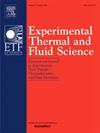Impact of physical properties of coal slurry droplets on their interaction with coal particles
IF 2.8
2区 工程技术
Q2 ENGINEERING, MECHANICAL
Experimental Thermal and Fluid Science
Pub Date : 2025-03-21
DOI:10.1016/j.expthermflusci.2025.111478
引用次数: 0
Abstract
The use of alternative slurry fuels is a well-known approach to reducing hazardous emissions during combustion without a significant decrease in efficiency. Very little is currently known about the behavior of fuel droplets colliding with wall and with each other. It is important to understand these collisions to predict the processes characteristics during the spraying and subsequent combustion of a slurry fuel in a boiler furnace. Experiments into the collisions characteristics of coal-water slurry droplets were conducted, when varying the viscosity, density and surface tension of the slurry containing different sizes solid coal particles. The rheological characteristics of the slurry were varied by using such additives as transformer oil, neonol, emulsifier DcD, Tween-20 and Tween-80. The use of surfactants was found to reduce the critical resultant velocity of a droplet sufficient for its breakup. The obtained data were compared with earlier findings. It was established that the fuel compositions are non-Newtonian fluids that demonstrate different secondary atomization characteristics. Nevertheless, droplet-particle interaction regimes tended to be very similar, which is accounted for by inhomogeneity of liquids. A chart was also produced to illustrate the use of identified specific aspects of interaction of slurry droplets with solid particles in thermal engineering applications.

煤浆液滴物理性质对其与煤颗粒相互作用的影响
使用替代泥浆燃料是一种众所周知的方法,可以在燃烧过程中减少有害排放,而不会显著降低效率。目前,人们对燃料液滴与壁面碰撞以及相互碰撞的行为知之甚少。了解这些碰撞对预测浆液燃料在锅炉炉内喷射和随后燃烧的过程特性具有重要意义。通过实验研究了不同粒径固体煤颗粒的黏度、密度和表面张力对水煤浆水滴碰撞特性的影响。变压器油、新醇、乳化剂DcD、Tween-20、Tween-80等添加剂的加入改变了浆料的流变特性。发现使用表面活性剂可以降低足以使液滴破裂的临界合成速度。获得的数据与先前的发现进行了比较。确定了燃料成分是具有不同二次雾化特性的非牛顿流体。然而,由于液体的不均匀性,液滴-粒子的相互作用机制趋于非常相似。还制作了一个图表来说明在热工应用中确定的浆液液滴与固体颗粒相互作用的具体方面的使用。
本文章由计算机程序翻译,如有差异,请以英文原文为准。
求助全文
约1分钟内获得全文
求助全文
来源期刊

Experimental Thermal and Fluid Science
工程技术-工程:机械
CiteScore
6.70
自引率
3.10%
发文量
159
审稿时长
34 days
期刊介绍:
Experimental Thermal and Fluid Science provides a forum for research emphasizing experimental work that enhances fundamental understanding of heat transfer, thermodynamics, and fluid mechanics. In addition to the principal areas of research, the journal covers research results in related fields, including combined heat and mass transfer, flows with phase transition, micro- and nano-scale systems, multiphase flow, combustion, radiative transfer, porous media, cryogenics, turbulence, and novel experimental techniques.
 求助内容:
求助内容: 应助结果提醒方式:
应助结果提醒方式:


